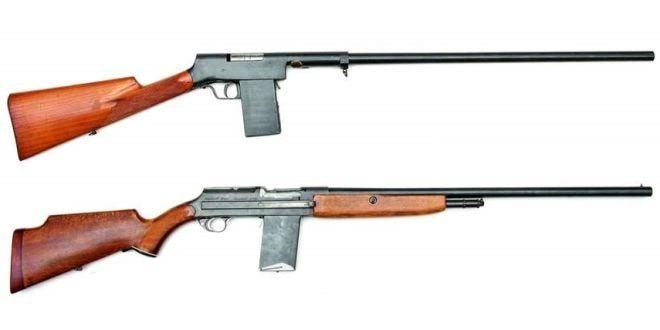In the Soviet Union, arms designing was almost exclusively done in government armories and design bureaus. And only on very rare occasions, individuals could be licensed to design firearms. This article tells about one of such independent designers – a gentleman named Firs Barkanov. The article is based on the story published by the Kalashnikov Gun Magazine. Mikhail Degtyaryov, the chief editor of that magazine, kindly provided us the rights to use the content.

Firs Barkanov
Let’s first imagine the environment that Bakanov was working in. First of all, he had to be stubborn and talented enough to manage to convince the government officials to give him that unbelievable-for-USSR permission of independent arms designing. However, that is only the half of difficulties he would face. Barkanov had no access to the huge amount of statistical data, drawings, existing gun samples, reports and other useful information and items that have been collected over the years in government armories. All he could use is the scarce amount of information concerning firearms design that was not classified and the firearms that he could own as a civilian. Other than that, he was pretty much on his own. Trials and errors along with his talent and skills were his main tools to design the guns.
Among the known firearms designed by Barkanov, there are two shotguns and a handgun. None of these firearms were ever mass produced and they exist in single samples. All of these guns were in Barkanov’s own collection up until his death in 1983 when his wife donated the guns to the Military-Historical Museum of Artillery, Engineer and Signal Corps located in Saint Petersburg, Russia. These firearms are still a part of the huge small arms collection of that museum. Let’s take a closer look at each of Barkanov guns.
Barkanov Shotgun Model 1957

As seen in the above image, this is a magazine fed shotgun. The action consists of a fixed breech and movable barrel. The lockup of the action is accomplished by the rotation of the barrel. A locking lug on the barrel engages the locking recess on the receiver as shown in the image below.

This shotgun is striker fired with a double action only trigger mechanism. It is fed from a single stack detachable box magazine. Presumably, it was a manual repeater. It is also possible that either the design of this shotgun was not finished or it lacks a handguard or other mechanism of operating the action.

On the left side of the receiver, there is a marking saying “Leningrad-1957y. Barkanov Firs.”. Leningrad is the name of Saint Petersburg during the Soviet era. Below the text, there is Barkanov’s own stamp in a form of a stylized triangle.
Barkanov Semi-Auto Shotgun, Model 1966

Unlike the previous shotgun, this one is a much more refined design. It is a semi-automatic gas operated firearm chambered in 16 gauge. Because it would be too difficult or even impossible for a private gun designer to make a barrel, Barkanov borrowed it from some production model shotgun.
The barrel length is 685mm (27″). The overall length of this shotgun is 1,260mm (49.6″) and the empty weight is 3,085 grams (6 lbs 13 oz).

The Model 1966 shotgun feeds from a detachable box magazine of 5 round capacity.
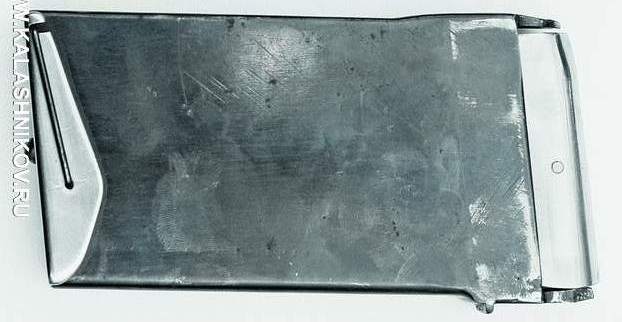
The lockup is accomplished via a vertically tilting bolt with its tail locking into the ejection port. The gun has a fixed ejector. In order to ensure a smooth operation and minimize the friction of parts, there is a roller built into the bottom rear portion of the bolt.
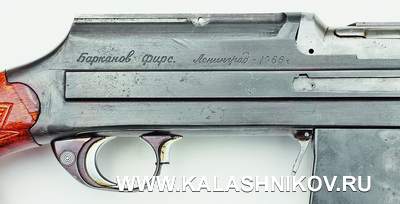
The marking on the right side of the receiver says: “Barkanov Firs. Leningrad 1966 y”.
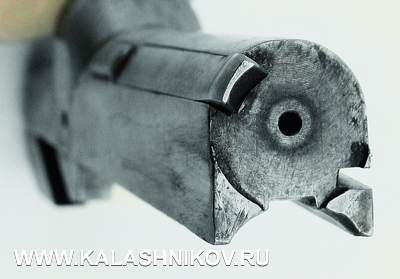


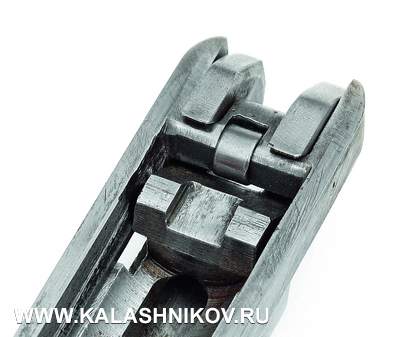
Unlike the Model 1957, the Model 1966 is a hammer fired shotgun.
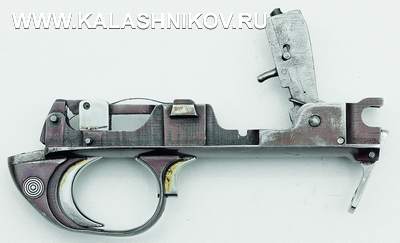
The disassembly of this shotgun starts with the removal of the handguard which then allows unscrewing the barrel. In order to make the barrel disassembly easier, the charging handle has a built-in latch which allows locking the bolt on its rearmost position thus removing the pressure from the barrel and making it easier to unscrew the barrel.
Another notable feature of this shotgun is the existence of a T-shaped bracket milled into the top of the receiver which is most likely a scope mounting provision.

Perhaps the most interesting design feature is the way its gas system operates. Let’s take a look at an image from that patent and the external appearance of the gas mechanism and see how it works.

Main parts of the gas mechanism are the gas tube (1 in the drawing), gas chamber (4) and the gas piston (6). The gas piston head is partially fluted. The flutings don’t go all the way resulting in a solid bolt head surface matching the internal diameter of the gas tube. Upon firing, the gasses from the barrel (2) pass to the gas tube via the gas port (3). The gasses push the piston forward into the gas expansion chamber (4). After a very short distance of forward movement, the fluted part of the piston head gets into the gas chamber thus allowing the gasses to pass into that chamber and pressurize it. In other words, the piston in the described phase of operation works like a valve of an internal combustion engine.

As soon as the projectile leaves the barrel and the pressure inside the bore drops, the pressurized gasses inside the gas chamber start to expand back thus pushing the piston back into the gas tube. The gases keep pushing the piston rearward until it clears the gas port (3). Interesting to note that the excessive gasses go back into the bore via the exposed gas port. I think the gas port must have been drilled at an angle to direct these excessive gasses forward to the muzzle rather than to the breach. Such angled cutout of the gas port would also allow having a cleaner action pushing the remaining gasses inside the bore out from the muzzle – much like the bore evacuator works on tank barrels.
At this point, the piston has traveled rearward for enough distance and with an enough force to cycle the action. Once the bolt extracts and ejects the spent shell, the compressed recoil spring returns the reciprocating parts to their initial position chambering a new round and locking the action.
Really unusual and complicated action, isn’t it? Why the designer chose that system is hard to tell now. Maybe he was experimenting to find out the possible advantages of this system. I think this mechanism could potentially have an advantage of smoother, less violent action which in its turn could result in a softer felt recoil.
R-4 Pistol Customized by Barkanov

This handgun is not designed by Firs Barkanov from the ground up. It is rather Barkanov’s customization of a Soviet rimfire pistol called R-4 which in its turn is based on the Tokarev pistol.
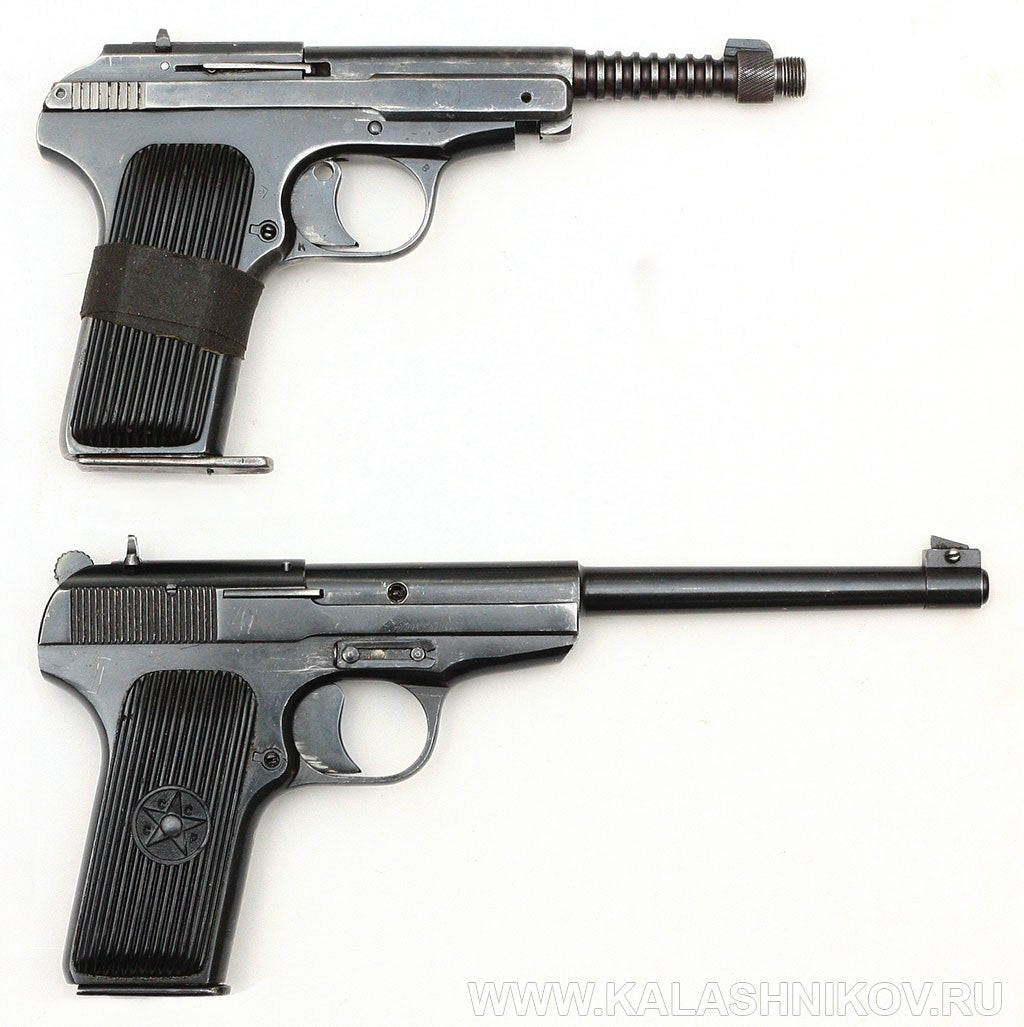
Barkanov’s design (top) compared to the original R-4 rimfire pistol (bottom).
Barkanov used the R-4 pistol frame and the magazine. He redesigned the slide and the trigger mechanism. He also made a shorter, ribbed barrel.

Unfortunately, other than these obvious differences, there is no other information. It is unknown why Barkanov changed the slide design or used such a barrel profile. The trigger mechanism of the only existing sample misses some parts which makes it even more difficult to find out what he was trying to do.
These are the three firearms designed by Firs Barkanov – an independent gunsmith licensed by the Soviet Union. Among other such sole designers is another gentleman named Vladimir Gerasimenko whos firearms we’ll discuss in a separate article.
Sources:
Chumak R. (2017, June 26). Ружья Барканова (Barkanov Shotguns). Kalashnikov Gun Magazine. Retrieved from: https://www.kalashnikov.ru/ruzhya-barkanova/
Chumak R. (2017, November 16). Новые сведения (New Information). Kalashnikov Gun Magazine. Retrieved from: https://www.kalashnikov.ru/novye-svedeniya/
 Your Privacy Choices
Your Privacy Choices
